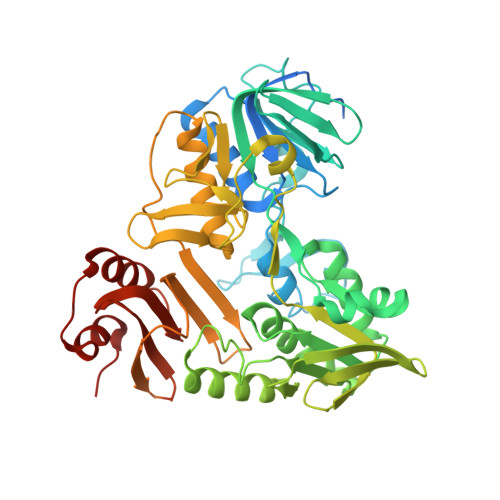Defining NADH-Driven Allostery Regulating Apoptosis-Inducing Factor.
Brosey, C.A., Ho, C., Long, W.Z., Singh, S., Burnett, K., Hura, G.L., Nix, J.C., Bowman, G.R., Ellenberger, T., Tainer, J.A.(2016) Structure 24: 2067-2079
- PubMed: 27818101
- DOI: https://doi.org/10.1016/j.str.2016.09.012
- Primary Citation of Related Structures:
5KVH, 5KVI - PubMed Abstract:
Apoptosis-inducing factor (AIF) is critical for mitochondrial respiratory complex biogenesis and for mediating necroptotic parthanatos; these functions are seemingly regulated by enigmatic allosteric switching driven by NADH charge-transfer complex (CTC) formation. Here, we define molecular pathways linking AIF's active site to allosteric switching regions by characterizing dimer-permissive mutants using small-angle X-ray scattering (SAXS) and crystallography and by probing AIF-CTC communication networks using molecular dynamics simulations. Collective results identify two pathways propagating allostery from the CTC active site: (1) active-site H454 links to S480 of AIF's central β-strand to modulate a hydrophobic border at the dimerization interface, and (2) an interaction network links AIF's FAD cofactor, central β-strand, and Cβ-clasp whereby R529 reorientation initiates C-loop release during CTC formation. This knowledge of AIF allostery and its flavoswitch mechanism provides a foundation for biologically understanding and biomedically controlling its participation in mitochondrial homeostasis and cell death.
Organizational Affiliation:
Biochemistry and Molecular Biophysics, Washington University School of Medicine, St. Louis, MO 63110, USA; Molecular and Cellular Oncology, The University of Texas M.D. Anderson Cancer Center, Houston, TX 77030, USA. Electronic address: cabrosey@mdanderson.org.
















